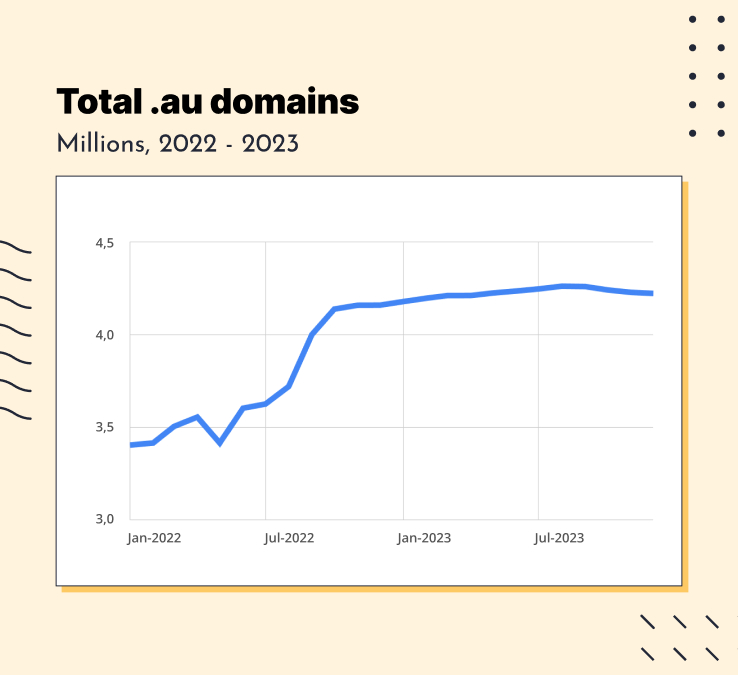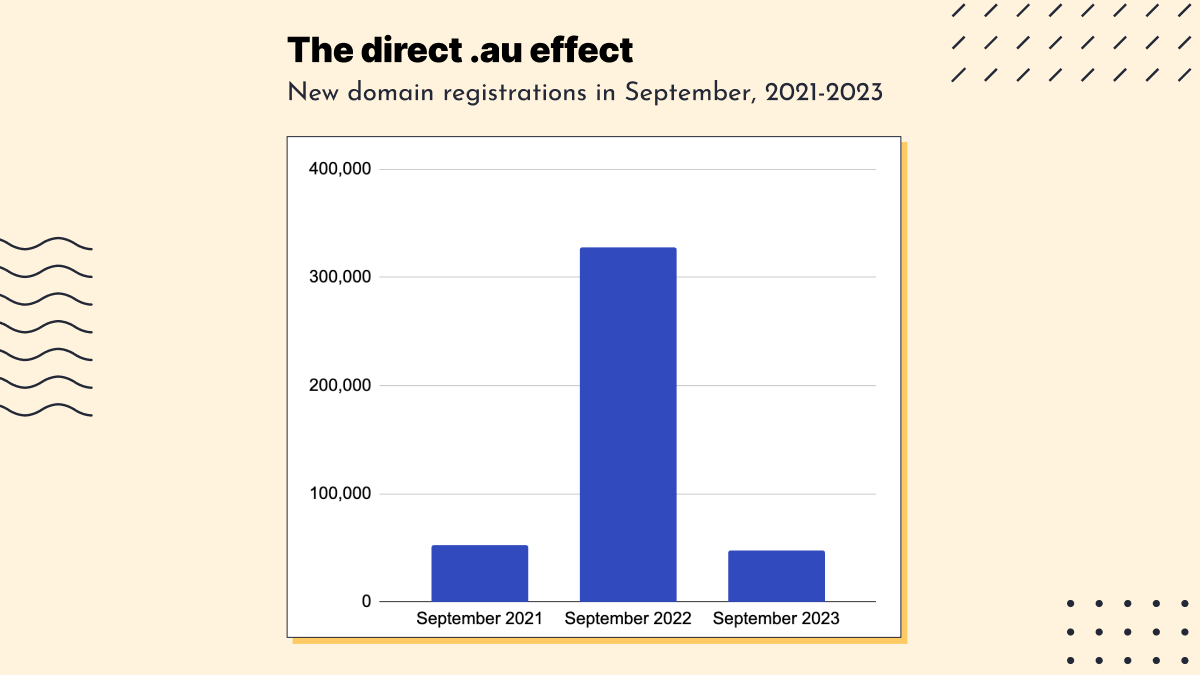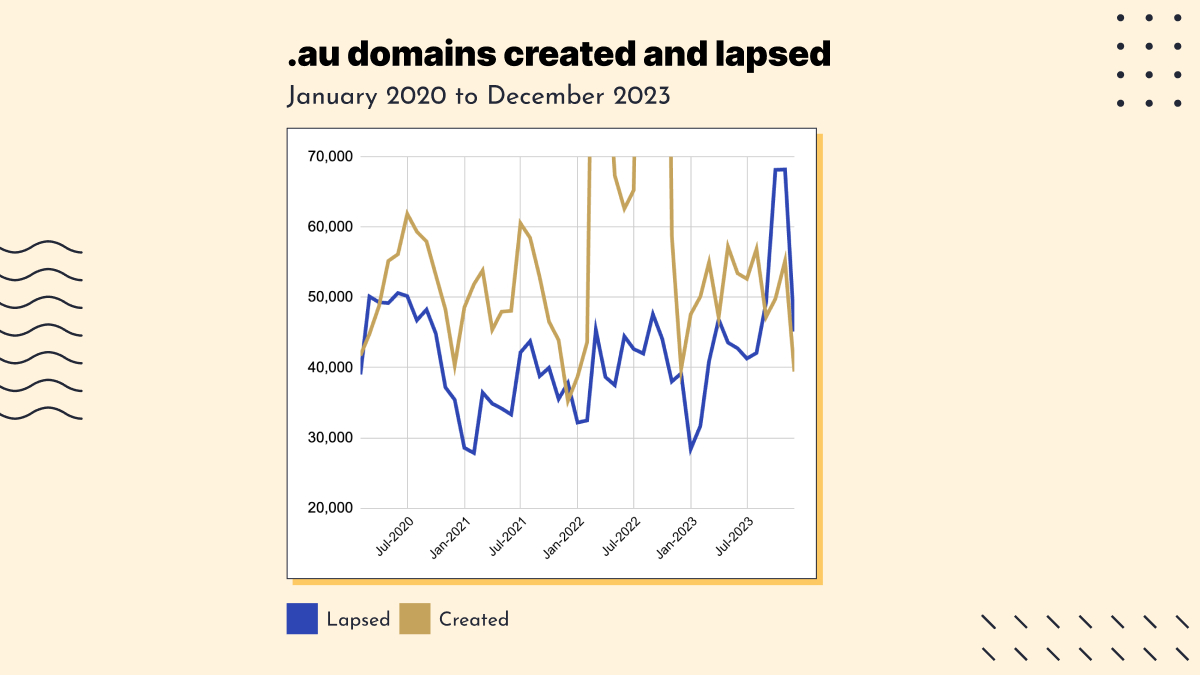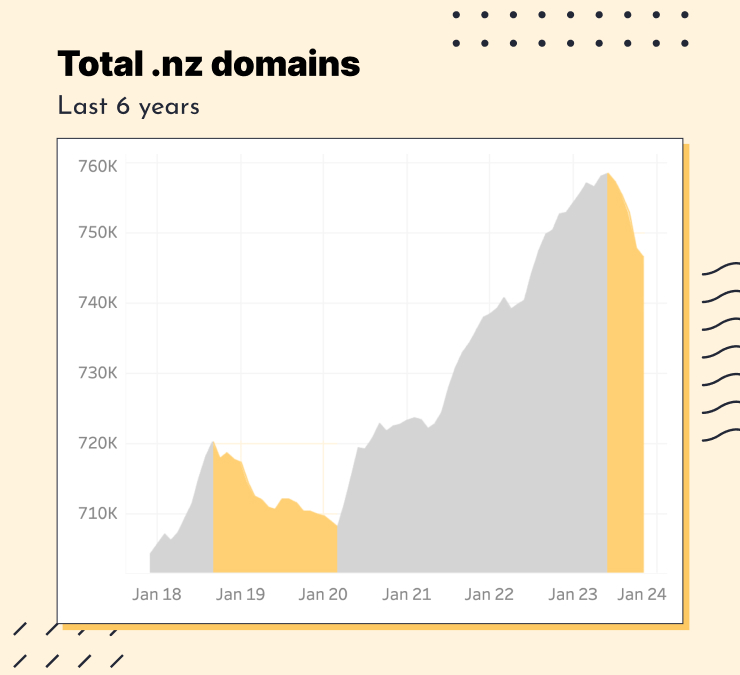The .au namespace is shrinking
In just four months, 39,000 .au domains have disappeared. What’s going on? And how long will it last?

At the end of 2023, over 4.2 million .au domains were registered (including .com.au, .au, .net.au, etc). This number had grown by over a million just in the 2020s. Growth was almost the only way: Only three times in the first 44 months of this decade did the total number of domains slip backwards.
Until last September, when something very unusual started happening. And it hasn’t stopped yet.
The number of registered .au domains is dropping. Official auDA stats are available to December 2023, and the total has fallen in each of the last four months. In all 39,142 .au domains have fallen away since August. There’s no reason to think that things will have improved since then.
We know all this thanks to regular reports from auDA (.au Domain Administration). Here’s the total since the start of 2020. As you can see, for almost all that time the only way has been up:

This article is mostly about the dip at the top-right corner of the graph above. But before we get into that, let’s look at the most striking part of the blue line.
2022: The direct .au boom
You’re quite possibly wondering what happened through the middle half of 2022 to send the line almost vertical. That steep climb happened thanks to the launch of direct .au domains (like example.au rather than example.com.au).
Because of this digital landrush, we can’t really compare 2022 statistics to other years. Take September as an example. In 2021 and 2023 that was a fairly typical month, in the region of 50,000 new registrations. In between, during the direct.au frenzy, September 2022 saw 328,000 new domain registrations!

This is a bit of a headache when you’re trying to figure out how strange today’s decline is. As we dig into the figures, keep this quirk in mind.
A bit of perspective
39,000 sounds like a lot of domains - and in a way, it is. But this isn’t exactly a massive collapse. It’s less than 1% of all .au domains. There are still plenty of websites and email addresses that end in .au, and that’s not going to change any time soon.
But when the normal state of affairs is consistent growth, this decline is still worth looking into.
The stock of .au domains is being drained as people don’t renew domains, and it isn’t being replenished anywhere near as much as usual.
The first culprit: Low renewal numbers
When you register a new domain, you choose a period of 1 or more years. After that time you have the option to renew it for another year (or more).
If you don’t renew your domain, it falls out of the total. There are two long-run trends when it comes to lapsing .au domains.
- Firstly, in a normal month you’d expect 30-50,000 of them.
- Secondly, it’s usually a safe bet that more new domains will be registered than will lapse in any given month.
These trends held very steady through this decade, until September 2023. That’s when they both disappeared. This graph shows lapsed domains in blue, and new registrations in yellow. We’ve cut out the peaks of the 2022 boom so we can focus on the gap between the two lines.

For years, Australia merrily added more domains (the yellow line) than it lost (blue). Lapsed domains then shot upwards into record territory from August to October. That’s what started the current period of decline.
Low domain creation has followed
For a couple of months, the number of new domain registrations stayed normal even as lapsed domains spiked. But that turned at the very end of 2023. The domain recession may have been started by a lack of renewals, but a lack of registrations is firmly in the mix now too.
It’s a double-whammy. The stock of .au domains is being drained as people don’t renew domains, and it isn’t being replenished anywhere near as much as usual.
It's not just Aussie
Because we also do business in New Zealand, we have an eye on .nz domain stats as well. The picture there is actually a bit worse than the .au namespace.

Shrinkage hit New Zealand a couple months earlier than Australia. So far, losses there equate to 1.6% of domains (versus .92% for .au).
Like Australia, .nz domains saw a decline in renewals first, and then lower registrations followed. So it’s fair to guess that whatever trends are happening here to drive a drop in domains is also happening there. It’s not just Australia - we’re talking international trends.
And that’s the data analysis done. Now let’s break out a crystal ball and predict the future.
How long will this last?
Predictions are hard, of course, but it seems safe to say that this domain recession is going to continue a while longer. The only other comparable situation that we found on either side of the Tasman happened in New Zealand at the end of the last decade, and it lasted 18 months. Today’s .au decline only started last spring.
Plenty of future losses will already be locked in, so we expect numbers of lapsed domains to stay high. Even if you take your website offline and close down your email address, your domain is registered until it expires. It won’t show up in the statistics until then, which could take years. There are bound to be more abandoned domains waiting to lapse.
In all 39,142 .au domains have fallen away since August.
Some of the current decline could be down to the rush to register direct .au domains in 2022. Organisations that switched from something like .com.au or .org.au to a direct .au domain might be letting the old domain lapse (not that changing domains is as easy as it sounds). Or direct .au domains that were grabbed on a whim (or “just in case”) might be expiring after going unused.
Around the world, domains that are dropping off the internet probably include covid-era side hustles, fun ideas that are harder to pay for when the cost of living is biting, and businesses cutting nonessential domains (like short-term campaign websites, or domains that they’ve been sitting on just to stop anyone else from grabbing them).
Domain creation is harder to predict. But if domain registration is mostly an economic activity - a sign that someone’s going into business, for example - then it will only rise with confidence levels. Or when the cost of living and inflation stop clouding the future so much. Even economists struggle to say when that will happen.
Could your .au domain be cheaper?
People are cutting back what they spend on domains, so let’s finish with a quick word about prices. The same .au domain carries a different cost at different retailers. The bottom line is that our .au price, NZ$25.95/yr (plus $10 for optional domain privacy), is cheaper than the regular renewal prices at:
- MelbourneIT - $79/yr
- HostPapa - $20.99 + $29.95 for “essentials”
- Webcentral - $23.95 + $14.95 for privacy
Every dollar counts, and by transferring domains to us, you can save money over any of these competitors - and many others.
Hosting and Domains
Explore the MyHost range
Domains
From $25.95/yr
Web Hosting
From $8.95/mo
Virtual Servers (VPS)
From $19.95/mo
Email Hosting
From $4.95/mo
Any questions?
Ask us anything about domains, web hosting, or anything else you need to get your business online.
Contact usReal words from real MyHost customers
Went from Crazy Domains to MyHost and the service in both is very good, however the speed and ease of use is not even comparable. If your looking for a easy to modify and simple hosting/domain service MyHost is where you go. The price is way better, the speed was within two hours to change and any adjustments to DNS settings happen instantly, not to mention your DNS is fully customizable at the basic rate. ★★★★★

The support team always seem to go above and beyond, honestly couldn't ask for anything more.

Fantastic support. Good pricing ...and a control panel that just works without trying to up-sell and randomly include extra things I didn't ask for.
So impressed, I'm migrating domains from a number of other providers who struggle with one or more of the above.

